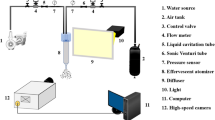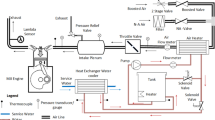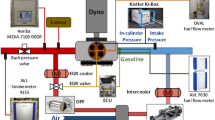Abstract
The atomization process that occurs in fuel injectors has a strong relation with the subsequent combustion reaction and thus with the engine thermal efficiency. Experiments were performed to investigate the fuel temperature effect on atomization parameters in a pressure-swirl atomizer. The experimental apparatus consisted of a flow control rig connected with a heat control system. The flow rig was built specifically for that purpose and the heat system goal was to vary the fuel temperature. The atomization parameters were evaluated by means of Shadowgraphy technique. Gasoline and ethanol in different temperatures, from 16 to 55 \(^{\circ }\)C, were used to provide variation in liquid properties and the same injection pressure (0.3 MPa) was used for both fuels. The results for drop sizing were expressed in terms of Sauter mean diameter (SMD) and the velocity field as well as the particle size distribution measurements were taken into two different axial distances from the nozzle exit. SMD and velocity field were also evaluated as function of injection pressure (from 0.1 to 0.5 MPa) as an additional test. At both distances, 25 and 100 mm, SMD and velocity seemed to be insensitive to the range of temperature used because it provided low variation in fuel properties. On the other hand, particle size distribution allowed the visualization of temperature effect on drop diameters, showing that increasing temperatures decrease droplet sizes, and the comparison between two axial distances allowed seeing the effects of first and second atomization on the spray.


















Similar content being viewed by others
Abbreviations
- CCD:
-
Charge-coupled device
- LD:
-
Laser diffraction
- PDA:
-
Phase Doppler anemometry
- PFI:
-
Port fuel injection
- PIV:
-
Particle image velocimetry
- PTV:
-
Particle tracking velocimetry
- PWM:
-
Pulse width modulation
- SMD:
-
Sauter mean diameter
References
Aleiferis PG, Serras-Pereira J, van Romunde Z, Caine J, Wirth M (2010) Mechanisms of spray formation and combustion from a multi-hole injector with e85 and gasoline. Combust Flame 157(4):735–756
Anand TNC, Madan Mohan A, Ravikrishna RV (2012) Spray characterization of gasoline-ethanol blends from a multi-hole port fuel injector. Fuel 102:613–623
Boggavarapu P, Ravikrishna R (2013) A review on atomization and sprays of biofuels for ic engine applications. Int J Spray Combust Dyn 5(2):85–122
Chen SK, Lefebvre AH, Rollbuhler J (1991) Influence of liquid viscosity on pressure-swirl atomizer performance. At Sprays 1(1):1–22
Gao J, Jiang D, Huang Z (2007) Spray properties of alternative fuels: a comparative analysis of ethanol–gasoline blends and gasoline. Fuel 86(10–11):1645–1650
Goldsworthy L, Bong C, Brandner PA (2011) Measurements of diesel spray dynamics and the influence of fuel viscosity using piv and shadowgraphy. At Sprays 21(2):167–178
Kashdan J, Shrimpton J, Whybrew A (2003) Two-phase flow characterization by automated digital image analysis. Part 1: fundamental principles and calibration of the technique. Particle Particle Syst Charact 20(6):387–397. doi:10.1002/ppsc.200300897
Keller P, Knorsch T, Wensing M, Hasse C (2015) Experimental and numerical analysis of iso-octane/ethanol sprays under gasoline engine conditions. Int J Heat Mass Transfer 84:497–510
Kim KS, Kim SS (1994) Drop sizing and depth-of-field correction in tv imaging. At Sprays 4(1):65–78
Lee CS, Chon MS, Kim DS (2001) Spray structure and characteristics of high-pressure gasoline injectors for direct-injection engine applications. At Sprays 11(1):35–48
Lefebvre A (1988) Atomization and sprays. Taylor & Francis, UK
Li T, Deng K, Peng H, Wu C (2013) Effect of partial-heating of the intake port on the mixture preparation and combustion of the first cranking cycle during the cold-start stage of port fuel injection engine. Exp Thermal Fluid Sci 49:14–21
Monteiro Sales LC, Sodre JR (2012) Cold start characteristics of an ethanol-fueled engine with heated intake air and fuel. Appl Thermal Eng 40:198–201. doi:10.1016/j.applthermaleng.2012.01.057
Padala S, Kook S, Hawkes ER (2013a) Effect of ethanol port-fuel-injector position on dual-fuel combustion in an automotive-size diesel engine. Energy Fuels 28(1):340–348
Padala S, Le MK, Kook S, Hawkes ER (2013b) Imaging diagnostics of ethanol port fuel injection sprays for automobile engine applications. Appl Thermal Eng 52(1):24–37
Padala S, Kook S, Hawkes ER (2011) Effect of ethanol and ambient pressure on port-fuel-injection sprays in an optically accessible intake chamber. At Sprays 21(5):427–445
Park SH, Kim HJ, Suh HK, Lee CS (2009) Atomization and spray characteristics of bioethanol and bioethanol blended gasoline fuel injected through a direct injection gasoline injector. Int J Heat Fluid Flow 30(6):1183–1192
Vazquez G, Alvarez E, Navaza JM (1995) Surface tension of alcohol water + water from 20 to 50.degree.c. J Chem Eng Data 40(3):611–614
Wang F, Wu J, Liu Z (2006) Surface tensions of mixtures of diesel oil or gasoline and dimethoxymethane, dimethyl carbonate, or ethanol. Energy Fuels 20(6):2471–2474
Wang X, Gao J, Jiang D, Huang Z, Chen W (2005) Spray characteristics of high-pressure swirl injector fueled with methanol and ethanol. Energy Fuels 19(6):2394–2401
Zhang J, Yao S, Patel H, Fang T (2011) An experimental study on gasoline direct-injection spray and atomization characteristics of alcohol fuels and isooctane. At Sprays 21(5):363–374
Acknowledgments
I would like to thank Magneti Marelli Powertrain Brazil for the sponsorship, CAPES for the masters program scholarship, FAEPEX for the research financial support and Laboratory of Chemical Engineering (PQGe) from Unicamp for the space and equipment assigned.
Author information
Authors and Affiliations
Corresponding author
Additional information
Technical Editor: Luis Fernando Figueira da Silva.
Rights and permissions
About this article
Cite this article
Fajgenbaum, R., Gonçalves dos Santos, R. Influence of fuel temperature on atomization parameters in a pressure-swirl atomizer from a port fuel injector by Shadowgraphy technique. J Braz. Soc. Mech. Sci. Eng. 38, 1877–1892 (2016). https://doi.org/10.1007/s40430-015-0443-0
Received:
Accepted:
Published:
Issue Date:
DOI: https://doi.org/10.1007/s40430-015-0443-0




